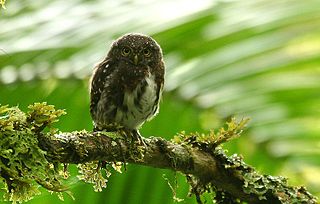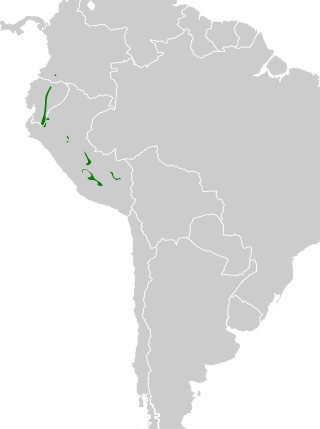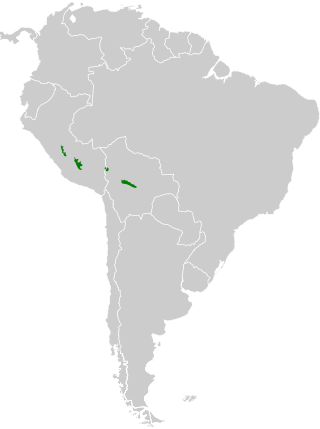
Pygmy owls are members of the genus Glaucidium. They belong to the typical owl family, Strigidae. The genus consists of 29 species distributed worldwide. These are mostly small owls, and some of the species are called "owlets". Most pygmy owl species are nocturnal and they mainly hunt large insects and other small prey.

The Amazonian pygmy owl, also known as Hardy’s pygmy owl, is an owl found in northern South America and the Amazon Basin. A member of the Strigidae family, it is a true owl.

The blackish nightjar is a species of bird in the family Caprimulgidae. It is found in Brazil, Bolivia, Colombia, Ecuador, French Guiana, Guyana, Peru, Suriname, and Venezuela.

The Costa Rican pygmy owl is a small "typical owl" in subfamily Surniinae. It is found in Costa Rica and Panama.

The Central American pygmy owl is a species of owl in the family Strigidae. It is found in Belize, Colombia, Costa Rica, Ecuador, Guatemala, Honduras, Mexico, Nicaragua, and Panama.

The Andean pygmy owl is a species of owl in the family Strigidae. It is found in Colombia, Ecuador, Peru, and Venezuela.

The austral pygmy owl is a species of owl in the family Strigidae. It is found in Argentina and Chile.

The cloud-forest pygmy owl is a short, muscular, small-sized species of owl found throughout the Andes of western Colombia and north-western Ecuador, being confined to cloud forests between 900–2000 m a.s.l. Below this altitudinal range the Central American pygmy owl occurs; above it, the Andean pygmy owl occurs.

The Colima pygmy owl is a species of owl in the family Strigidae. It is endemic to the western part of Mexico.

The subtropical pygmy owl is a species of owl in the family Strigidae. It is found in Bolivia, Colombia, Ecuador, and Peru.

The Pacific pygmy owl or Peruvian pygmy owl is a small "typical owl" in subfamily Surniinae. It is found in Chile, Ecuador, and Peru.

The Cuban pygmy owl is a species of owl in the family Strigidae that is endemic to Cuba.

The black-capped screech owl, or variable screech owl, is a species of owl in the family Strigidae. It is found in Argentina, Brazil, and Paraguay.

The Yungas screech owl, also known as montane forest screech-owl and Hoy's screech owl, is a species of owl in the family Strigidae. It is found in Argentina and Bolivia.

The cloud-forest screech owl is a species of owl in the family Strigidae. It is found in Bolivia and Peru.

The West Peruvian screech owl or Peruvian screech owl is a species of owl in the family Strigidae. It is found in Ecuador and Peru.

The smoky-brown woodpecker is a species of bird in subfamily Picinae of the woodpecker family Picidae. It is found in Argentina, Belize, Bolivia, Colombia, Costa Rica, Ecuador, El Salvador, Guatemala, Honduras, Mexico, Nicaragua, Panama, Peru, and Venezuela.

The Pernambuco pygmy owl is a species of owl in the family Strigidae. This species, first described in 2002, is endemic to Pernambuco state in Brazil.

The Guatemalan pygmy owl is a small "typical owl" in subfamily Surniinae. However, some taxonomic systems consider it to be a subspecies of northern pygmy owl. It is found in Mexico, Guatemala, and Honduras.

The foothill screech owl is a species of owl in the family Strigidae. It is found in Bolivia, Brazil, Colombia, Ecuador, Guyana, Suriname, and Venezuela.























